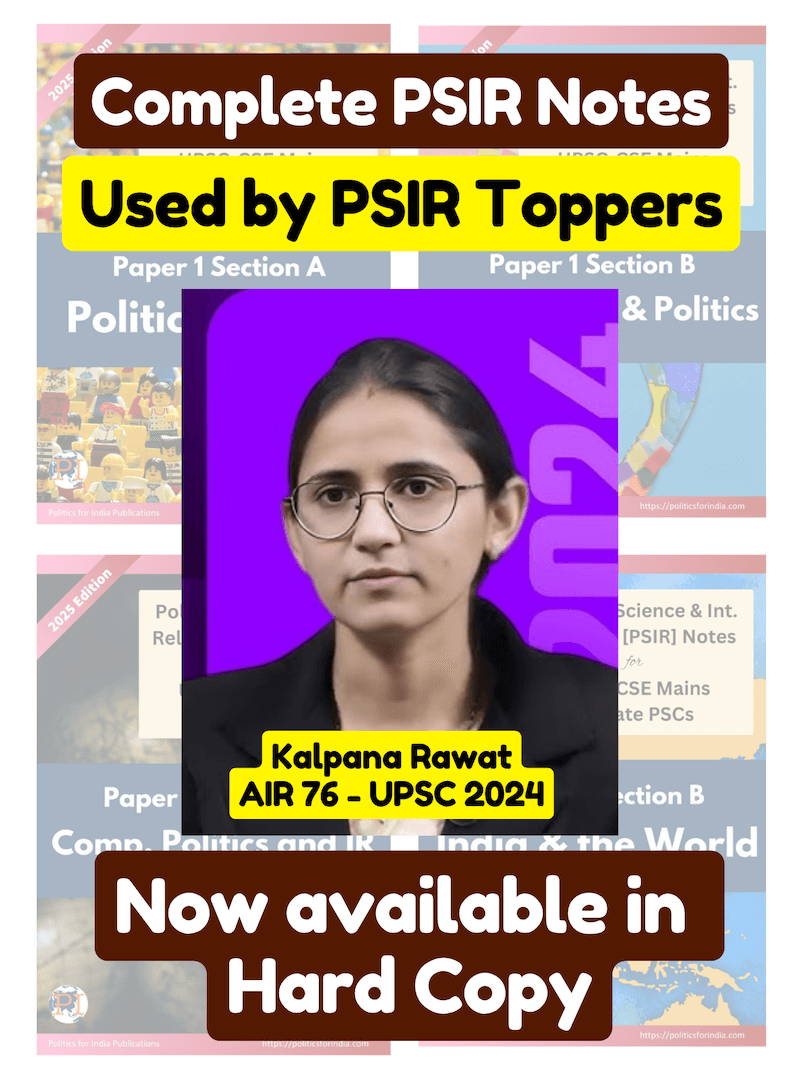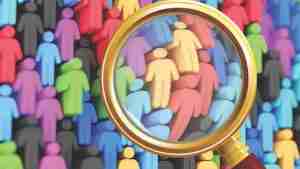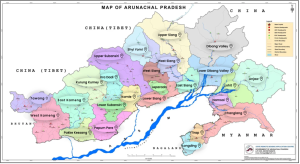1] Introduction
One Nation, One Election (ONOE) refers to holding elections to the Lok Sabha (House of the People) and all State Legislative Assemblies simultaneously. In this, voters across India cast ballots for the national parliament and their state assemblies on the same day (though in multiple phases).
ONOE has become politically significant as it touches deeply held values of Indian democracy. In (March 2024 – Reference), a Government’s High-Level Committee (HLC), headed by former President of India Dr. Ramnath Kovind submitted its report favouring ONOE. The report noted that such a system could “enhance administrative efficiency, reduce election-related expenditures, and promote policy continuity”.
2] Historical Background
ONOE is not a new concept to Indian polity. Between 1951–1967, i.e., immediately after independence, India conducted simultaneous polls. The Constitution itself implicitly anticipated this by fixing five-year terms for both Parliament and state legislatures (Article 83 and 172) from a common starting point.
However, that unbroken pattern ended in the late 60s when several state governments fell prematurely. In 1970 , the Lok Sabha was also dissolved a year early by Indira Gandhi. Since then, elections for Parliament and various state assemblies started occurring in different years.
The idea of ONOE, however, did not disappear. The Election Commission first formally endorsed synchronized elections in its 1983 Annual Report.
Later, the Law Commission, and a Parliamentary Standing Committee too recommended reviving the practice with necessary constitutional amendments. Even policy think-tanks like the NITI Aayog took note of the “wastage of public money” due to frequent elections in the country.
3] Constitutional and Legal Dimensions
Implementing ONOE in India requires substantial changes to the law.
Under the present Constitution, the tenure of Parliament and state legislatures are fixed at five years from their first sitting (Articles 83(2) and 172(1)). Elections must be held before the expiry of this term. If a House is dissolved early, the replacement elections starts a new five-year cycle.
The government’s 129th Constitution Amendment Bill (2024) aims to rewrite this electoral architecture so that future elections are “locked together.” This would insert a new Article 82A permitting synchronized elections to the Lok Sabha and all state assemblies. It would also amend Article 83 and 172.
Under Article 368, any change that affects the powers or structure of state legislatures must be ratified by at least half of the state assemblies. The Law Commission has also stressed this point, noting that at least 50% of states would need to agree to proposed amendments.
4] Theoretical Frameworks
Joseph Schumpeter famously defined democracy as the ‘method of competitive leadership selection through elections’. In that sense, ONOE is a desirable step as it promotes an “efficient” electoral system
Robert Dahl’s model of polyarchy, on the other hand, emphasizes broad citizen participation. He lists features like universal suffrage, free speech, and frequent elections as essential democratic conditions.
From Dahl’s perspective, more frequent elections and local contests deepen democracy by giving voters continual feedback mechanisms. In this regard, ONOE would make politicians complacent and voters disenchanted- undermining democratic deliberation.
Another relevant theory is electoral-cycle politics. Governments facing constant election focus more on preparing for upcoming elections rather than long term developmental goals. Parties frequently halt development work under the Model Code of Conduct. A NITI Aayog report rightly describes this as the “perpetual campaign mode.”
It is argued that synchronising elections would let governments pursue long-term policies without continual electioneering.
5] Political Implications
Advocates of single election insist that simultaneous elections preserve regional influence. In fact, the government’s report explicitly states that holding simultaneous polls “encourages a more localized focus during elections.”
Critics, however, worry that ONOE could nationalize state elections, favouring large national parties. They accuse the ruling party of pushing ONOE to concentrate power in their own hands.
A unified election with pan-India slogans could overshadow local issues. Indonesia’s recent experience illustrates this risk.
In 2019 and 2024 Indonesia held five simultaneous elections. In mid-2025 the Indonesian Constitutional Court ruled that – starting 2029 the country must separate national and local elections, because that would “elevate the importance of local issues”.
The implication is clear: when everything is bundled, local matters tend to be subordinated.
Further, some scholars also worry that simultaneous elections will undermine the parliamentary character of Indian democracy and shift India towards a more presidential-style politics. If all of India votes simultaneously, attention would naturally gravitate to the top leader. This might marginalize parliamentary coalition-building and weaken state leaders.
6] Administrative and Logistical Challenges
Putting ONOE into practice also poses huge logistical hurdles. The scale of India’s elections is vast. The Election Commission estimates that synchronising polls will require nearly 48 lakh voting machines and associated control units and VVPATs which is far beyond the current equipment stock.
Additionally, each election requires massive security deployment, who needs to be trained for multi-layer ballot and managing double the normal counting process. Warehousing, transporting, and safeguarding this extra machinery adds complexity.
In short, even if overall costs may fall, the one-shot election would demand a tremendous one-time surge in resources.
7] Comparative Global Perspective
A few countries can provide perspective on simultaneous polls. Sweden conducts all its elections together every four year. However, in Sweden this practice has not sparked a federalism debate because the nation is relatively homogenous. Still, it provides a model– a mature democracy where simultaneous multiple-level elections function smoothly.
South Africa also groups most elections every five years, except municipal elections. However, South Africa’s federal division of powers is also quite different from India’s (it is technically “unitary with devolved provinces”).
Indonesia is another country that has experimented with the idea of simultaneous elections. The controversies around it has already been discussed.
Notably, large federal democracies like the United States, Brazil, and Germany hold elections at different times for federal and state/regional offices. No major large federation has attempted full synchronization, which further underscores the novelty of India’s discussion.
8] Arguments In Favour of ONOE
Elections are expensive. The Law Commission and HLC emphasize that ONOE would “significantly cut down the financial costs associated with multiple election cycles.”
ONOE would give a big boost to efficient governance. Currently, each election invokes the Model Code of Conduct (MCC) period. During this period, government work freezes. Under ONOE there would still be a single MCC period. This would give a big boost to efficient governance.
With only one election every five years, governments could also spend the rest of the term on policy rather than perpetual campaigning.
It would also promote a stable, predictable environment for the economy, that would create better entrepreneurial environment. Therefore, several business groups, such as CII, FICCI, ASSOCHAM, etc have supported ONOE.
9] Arguments against ONOE
The criticism of ONOE is mainly based on larger normative questions around democracy. ONOE is often cast as “efficiency vs. deliberation.” It is also feared that ONOE centralizes national politics at the expense of regional autonomy.
Further, overhauling electoral timing midstream involves ethical questions. It might be viewed as subverting the democratic mandate, unless there is widespread consent. Some legal experts dub this a violation of “constitutional morality” if done without broad citizen agreement.
At the end, the large capital expense of extra EVMs/VVPATs and other transition costs will offset the estimated ₹45billion annual saving from fewer polls- One of the most vocal argument in support of ONOE. Apart from that, potential political costs (like voter alienation from the elections) are hard to quantify but could be substantial.
10] Conclusion
Simultaneous elections suggest a fundamental change in Indian Polity. India has refrained from such large scale experiments since independence. While there is lure of reduced election expenditure and avoiding the ‘perpetual campaigning mode’, the fears are also real.
The government of the day may become unaccountable for the next five years. This will reduce the role of citizens as well as those of pressure groups and social movements.
Plato predicted that a democracy (rule of the people with political equality) will eventually degrade into a tyranny (rule of a despot). While there is similar fear associated with ONOE, let us hope that just like his idea of philosopher king, the theory of ‘decline of an ideal state’ also remains a theory.













